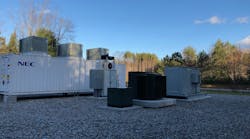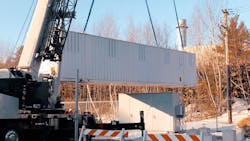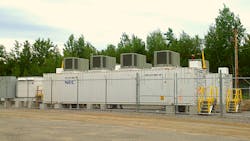Capacity, Flexibility and Resilience with BESS
The costs of installing and operating storage systems have declined significantly in recent years, enabling peak shaving to reduce ratepayer energy costs and utility participation in ancillary and frequency regulation markets to generate additional revenue. Madison Electric Works (MEW), a publicly owned utility in Madison, Maine, U.S., that serves about 2500 electric customers and has a 5-MW load across a 10-sq mile (26-sq km) radius, installed its first solar array (4 MW) in 2016. Two years later, the utility installed its first battery energy storage system (BESS) — 5-MW installation tied directly into the ISO New England (ISO-NE) grid — to provide energy, capacity and regulation to the market.
When MEW sought a way to provide further savings for its customers a few years later, it opted to install a 1.5-MW, 3-MWh behind-the-meter BESS to increase its energy storage capacity. The added storage capacity enables the utility to provide savings to its ratepayers through peak clipping and improve its resilience overall. Furthermore, when the battery is not being used to clip monthly and annual peaks, it participates in the frequency regulation and ancillary markets, creating an additional revenue stream for MEW.
The amount of revenue a battery storage facility can earn in the regulation market depends on when and how often it participates as well as on its overall performance score. On average, the ISO-NE regulation market offers about US$30/MW per hour. With MEW’s BESS typically providing about 1.5 MW per hour, it can earn around $45 each hour it participates in the regulation market.
Creating Cost Savings
Peak clipping, or the reduction of energy consumption during periods of maximum demand, represented an opportunity for MEW to provide savings to its ratepayers. MEW is charged a pro-rata share of regional network transmission service each month according to its coincident peak with the utility it is interconnected to, Central Maine Power. Capacity charges within ISO-NE paid to electric generating utilities are allocated similarly. However, load-serving entities are allocated based on the highest system hour of the year in the ISO-NE control area, rather than based on a monthly regional peak.
In both cases, by predicting Central Maine Power’s monthly peak or ISO-NE’s annual peak, and dispatching the battery during those times, MEW can reduce the regional transmission charges and capacity costs for its ratepayers.
After developing a comprehensive proforma, Agilitas Energy, the developer, owner and operator of MEW’s BESS, determined a two-hour BESS would provide the correct balance between peak load accuracy and capital cost (with the understanding there would be times when peak loads are not hit).
The parties agreed to a split savings concept, based on the reduced transmission charges MEW would pay ISO-NE and Central Maine Power compared to what it would have paid without the BESS reducing demand. MEW pays a portion of the reduced regional transmission and capacity cost savings to Agilitas. To supplement revenue, Agilitas participates in the ISO-NE frequency regulation and ancillary services markets, which provide hourly revenue streams based on market clearing prices and BESS participation, when the BESS is not needed for peak clipping.
To successfully participate in the frequency regulation market, MEW and Agilitas brought in Customized Energy Solutions (CES), an energy services and software provider with knowledge and experience in energy storage systems and ISO markets, to manage this aspect. From its 24/7 market operations and control center, CES dispatches more than 350 MW of energy storage systems across the country.
Design, Operate, Monitor
CES serves as the real-time interface between MEW’s BESS and ISO-NE. It provides hardware and software to the BESS to facilitate dispatch and meet the ISO’s data requirements. CES, along with Agilitas, helped MEW to meet the ISO’s ancillary services market requirement of registering its facility as an alternative technology regulating resource (ATRR). CES also is the designated monitoring entity for the facility — another requirement to participate in the ISO’s ancillary services market.
Lastly, ISO-NE requires telemetry between a battery storage facility and the ISO via a private network circuit, but it is not always feasible to run the private network circuit all the way to the individual battery storage facility. In some instances, as is the case with MEW’s BESS, a two-step data-transfer process is required. CES facilitates this data transfer through a remote terminal unit at the MEW site. The data is encrypted and sent to CES’s operations center, then passed to a dedicated ISO-NE remote terminal unit. Then the same thing happens in reverse. The entire process is monitored, ensuring MEW’s battery system is following the regulation signal, megawatt, or megavolt-ampere reactive and dispatching energy appropriately.
The telemetry also enables general monitoring, like for weather-related issues where a lightning strike or severe weather could cause the automatic recloser that sits between the battery facility and MEW system to open. Telemetry also ensures the BESS is always ready for peak shaving by looking at how many power blocks are on-line, the maximum charge/discharge capability of the facility.
CES also was tasked with operational duties like submitting ISO-NE regulation market offers and monitoring performance. The company set up systems and algorithms to track dispatch signals from the ISO and the response from the MEW facility within performance windows. This setup enables the company to detect when the battery storage facility is lagging and might fall outside those performance windows, so it can remove offers.
Since MEW’s second BESS site does not flow directly into the ISO-NE market and primarily serves to reduce the utility’s load and enable peak shaving, it is classified as a behind-the-meter site. However, since regulation provided from the site still benefits the ISO-NE system, the ISO’s rules allow the behind-the-meter BESS to participate in the regulation and ancillary service markets. These same rules also allow for aggregations of smaller, distributed resources, such as residential power packs, to participate in the markets.
In addition, CES provides a web display with real-time data on the facility for Agilitas. The dashboard shows what is happening with dispatch signals at any given time or over time, including the dispatch signal from ISO-NE, the response of the facility, the current remaining charge level as a percent of total capability and the remaining quantity of megawatt-hours stored in the facility.
Critical Communications
Because the primary purpose of the BESS facility is to provide peak shaving and participate in the ancillary services market, communications are especially vital. Any break in connection or downtime could hinder the storage system’s ability to follow signals and dispatch instructions, which could ultimately result in reduced savings or loss of qualification to participate in the regulation market.
As such, ensuring every connection to the site is solid and maintains uptime, and with the town of Madison providing fiber cable to the site, there have been few problems. CES has established code-driven, situation-dependent protocols and an alternative means of accessing the site in case primary communications falter. To ensure resiliency and uptime, CES also installed a backup cell connection. In addition, automation tools are used to guarantee operators get dispatched at the right time for peaks.
Promising Results
Since MEW’s behind-the-meter BESS went into operation, Agilitas has clipped about 70% of both the regional monthly peaks and annual capacity peaks, resulting in substantial savings for MEW ratepayers. The facility’s performance has been excellent, particularly outside of core COVID-19 months, which produced some outlying results because of the unpredictable energy peaks.
While it is impossible to eliminate 100% of demand peaks, those that put plans in place for when a battery trips off-line, maintenance needs to be performed, or an outage occurs will be able to get back on-line quickly and optimize cost savings. With the opportunity for more BESS deployments, it is possible for utilities, asset owners and ratepayers all to benefit from the additional revenue streams these battery storage systems can provide.
Marty Berry is superintendent at Madison Electric Works, a publicly owned utility serving roughly 2500 customers in Madison, Maine.
Erik Paulson serves as vice president of wholesale market services for Customized Energy Solutions (CES), where he is responsible for overseeing the management and scheduling of generation and energy storage assets in the various U.S. power markets as well as the electricity purchases and market activity for large users, including municipalities and industrial customers. Paulson also previously served in the Navy’s nuclear power program.
Jeff Perry serves as vice president of asset management for Agilitas Energy. He spent 14 years at COM/Electric (now Eversource), where he ran the power supply organization, and 12 years with Southern Energy, where he served as president of the New England and New York business units (which owned over 2500 MW of electric generation at the time). Perry has over 30 years of experience with the New England Power Pool and New York ISO markets. Perry also served as president of New England Battery Storage (NEBS). NEBS designed, built, owned and operated three stand-alone energy storage systems in New England, including ISO-NE’s first ever continuous storage facility.
Erik Paulson
Erik Paulson ([email protected]) serves as vice president of wholesale market services for Customized Energy Solutions (CES), where he is responsible for overseeing the management and scheduling of generation and energy storage assets in the various U.S. power markets as well as the electricity purchases and market activity for large users, including municipalities and industrial customers. Paulson also previously served in the Navy’s nuclear power program.
Marty Berry
Marty Berry ([email protected]) is superintendent at Madison Electric Works, a publicly owned utility serving roughly 2500 customers in Madison, Maine.
Jeff Perry
Jeff Perry ([email protected]) serves as vice president of asset management for Agilitas Energy. He spent 14 years at COM/Electric (now Eversource), where he ran the power supply organization, and 12 years with Southern Energy, where he served as president of the New England and New York business units (which owned over 2500 MW of electric generation at the time). Perry has over 30 years of experience with the New England Power Pool and New York ISO markets. Perry also served as president of New England Battery Storage (NEBS). NEBS designed, built, owned and operated three stand-alone energy storage systems in New England, including ISO-NE’s first ever continuous storage facility.





